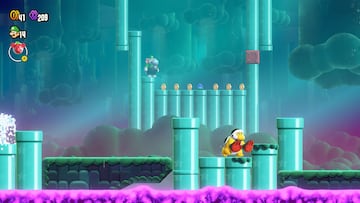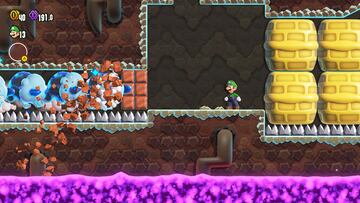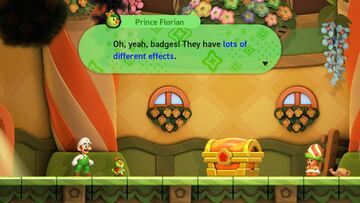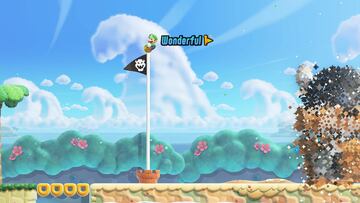Nintendo
Super Mario Bros. Wonder: Astonished by the Flower Kingdom
We have stepped into the Flower Kingdom of Super Mario Bros. Wonder, only to be astonished by a magnificent installment that brings us back to the king of 2D.
It’s hard to believe that it’s been almost 11 years since we’ve had a new Super Mario Bros. title in our hands. Although Nintendo’s famous plumber has appeared in a couple of 3D adventures, a few spin-offs, and several games where his name is an important part of the title, we haven’t had a 2D installment of his own that incorporated new gameplay details. Finally, Super Mario Bros. Wonder came into our hands to prove once again that platform titles can be full of imagination.
Welcome to the Flower Kingdom
Super Mario Bros. Wonder brings back Mario and his friends in a 2D platform game where you have to go through levels from one point to another, collecting items and avoiding enemies along the way. The game lets you play with a large number of characters, all of which are exactly the same in their playability. Mario, Luigi, Peach, Daisy, Blue Toad, Yellow Toad, and Toadette, as well as four colorful Yoshis and Nabbit, the latter characters being unable to take damage, making them ideal for beginners.
On this occasion, our characters are invited by Prince Florian to the peaceful Flower Kingdom, one of the Mushroom Kingdom’s neighboring kingdoms. However, Bowser steals a Wonder Flower, which merges with the kingdom’s castle and begins to sow the chaos that characterizes the King of the Koopas. Taking advantage of the fact that they are already there, Mario and company, accompanied by Prince Florian, begin their mission to stop the villain and restore peace to the Flower Kingdom. Certainly, nothing is reinvented in terms of story, although it does have a bit more detail than previous 2D titles.

A renewed Mario
One of the first things to notice about Super Mario Bros. Wonder is that many of the animations have been completely reworked. Mario and his friends still have their classic moves: jumping, crouching, spinning in the air, and more. But what is surprising is the way they do it now, with more expression in their faces and movements. Going in and out of pipes has more detail and extremely funny animations, and even running has a much more cartoonish style.
The game also features little animations that appear when you grab a power-up, making the characters stand out and even striking a pose. Throughout the levels, there are dialogues and phrases that accompany certain actions, such as killing enemies or picking up items. It’s not just the main characters that look more animated, but also the enemies and even the scenery with its the talking flowers. Love them or hate them, but they are an integral part of this installment. All of this makes the game feel more animated and gives the game an identity of its own that visually separates it from other installments.

A wonderful gameplay
Super Mario Bros. Wonder maintains the philosophy of making the gameplay easy to learn and difficult to master. At the beginning of the game, the levels tend to feel extremely easy, but that’s not to be taken for granted, as the game becomes more and more challenging, as well as a good experience for completionists thanks to the different items to be found.
In terms of gameplay, the first thing to highlight is the Wonder Flower. Each of the traditional levels (as well as others that are challenges) has this item that, when touched, creates an effect that completely plays with the level design, effects, and mechanics, creating unique experiences for the player. It is surprising how many ways the levels change and do so in unique ways, breaking with the details that have made the franchise what it is. Sometimes they create challenges that lead to new paths, sometimes they make you see a level from a different perspective or transform the level into something completely different. While the level design is very detailed, the Wonder Flower enhances what is already there.
Each effect of a Wonder Flower will reward us with a Wonder Seed, which will be a key collectibles to progress and complete 100% of the game. Some of these are obtained by exploring the level in depth and finding an extra exit (like in Super Mario World). There are also Flower Coins, which are the in-game currency we can use to buy special items or even open other paths to other areas.

Along with this, we have the new Power Ups, which, in addition to the return of the classic Mushroom and Fire Flower, include Elephant Fruit, Bubble Flower, and Drill Mushroom. The first one is the most infamous and turns us into an elephant that can use its trunk to throw water and jump higher, although it slows us down a bit. The Bubble Flower allows us to throw bubbles to catch small enemies and turn them into coins, as well as use them to jump over them. The Drill Mushroom, as the name suggests, is a drill that sits on our character’s head like a helmet and allows us to dig. Although the list of power-ups is limited, it is understood that this is so as not to clash with some of the many abilities of the badges.

Finally, we have the badges. These are items that you equip before entering each level that give you a different mechanic for our characters. Do you want to swim faster, have more blocks in the levels, or be invisible? You can do it, but only one at a time. The badge system is an extra that each character gets and can even make the adventure as easy or difficult as you want.
The badge system is divided into three parts. The action badges allow us to use an extra mechanic, like using a hat to float for an extra time, having an extra jump, or even throwing a kind of whip to reach the walls. Object badges give us a passive ability, like getting more coins or even being rescued when we fall into the void. Expert badges add more advanced mechanics or abilities, like one that lets your character run at full speed without stopping. The badge system is an addition to the game that is more about getting more out of the game than it is about changing the franchise.
Another Voice
We can’t talk about this title without mentioning the recent departure of Charles Martinet, who was the voice of Mario, Luigi, and other characters for many years. Fortunately, Kevin Afghani’s voice preserves the characteristics of these characters very well and doesn’t sound bad. The job is well done, and although we need to hear more of Mario’s new voice in the future, we feel he is on the right track.

Multiplayer and Post-Game
The multiplayer section is one to highlight, because, on the one hand, we have the experience inherited from the New Super Mario Bros. series, where up to 4 players can play at the same level at the same time. But this time, it opens up the possibility of online multiplayer, where not only can you play as you would in person, but you can also see the shadow of other players who are currently playing at the same level. If necessary, these players can rescue you, just like in the local co-op.
For its part, the post-game leaves something to be desired, with not much else to do once you reach 100%, which is between 15 and 20 hours of gameplay. While there are real challenges at the end of the road, it doesn’t feel as robust as other Mario titles of the past that allow you to keep playing once you’re done.

Super Mario Bros. Wonder is a title worth having in your Nintendo Switch library. Beyond the Super Mario name, being the first without Charles Martinet or any other nitpick you can think of, this new installment hits all the parameters you could expect from a 2D Mario platformer and then some. The game feels completely fresh, with surprises on every level. There is a balance between ease of play and difficulty that allows the game to be enjoyable for many. For a complicated 2023, this title does not disappoint.


